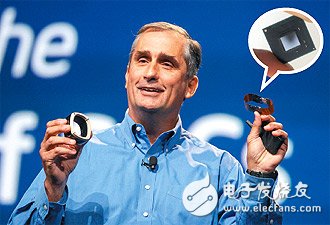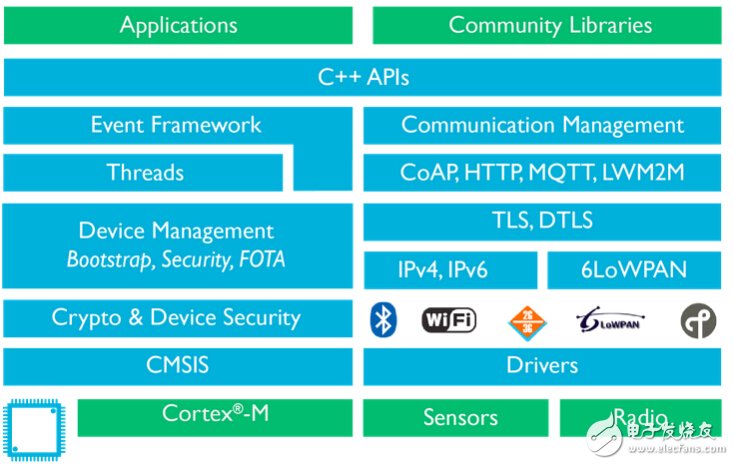At present, although the Internet of Things market is still in its infancy, most semiconductor giants have paid enough attention to it. From the latest release of the "2014 global semiconductor revenue rankings" list, the top semiconductor manufacturers will be more or less in contact with the Internet of Things. Although the Internet of Things involves a very broad field, in a limited number of hotspots, major manufacturers can't avoid face-to-face collisions, and they have created a competitive situation of “group battlesâ€. Xiaobian has compiled ten representative manufacturers from there to see their strategic layout of the Internet of Things.
Intel: Building a complete application environment based on Quark
Affected by the unsatisfactory development of the mobile chip market, Intel has shown an unprecedented positive attitude towards the layout of the Internet of Things. In addition to the establishment of a dedicated IoT business unit, Intel also launched the Quark series of processors for the IoT market in 2013, and built intelligent gateways and numerous embedded products based on this series of processors. In addition, Intel acquired the software company Wind River to provide a complete IoT application development environment through the Wind River Intelligent device platform.

The release of the Quark series processor, Intel blows the horn of the Internet of Things
At the same time, Intel also participated in the Industrial Internet Alliance established by a number of technology giants, including IBM, ATMT, General Electric, GE, and Cisco. The alliance is intended to create a wide range of IoT architectures, such as aerospace, healthcare, industrial manufacturing, smart cities and transportation, as well as security issues.
Main areas of focus: retail, transportation, industrial, intelligent buildings and smart homes, wearable devices
Representative products: intelligent gateway, Edison platform
Related information: Intel Edison platform Lushan true face sword refers to smart wearable device
ARM: Building an IoT ecosystem to consolidate dominance
ARM calls the Internet of Things world "a quiet change that is accelerating." "It's like everything is hidden under the iceberg, but it's a complex and orderly collaboration," said John Heinlein, vice president of global marketing at ARM.
The ecosystem is the survival of ARM. In the next-generation IoT market after smartphones and tablets, ARM will naturally not give up the ecosystem. The Cortex-M system is a tool for the ARM layout IoT market. At the same time, ARM is also working to solve the obstacles of the Internet of Things software. Last year, it launched a new software platform and mbed OS to help developers complete IoT devices. Product-level R&D and mass production. The acquisition of the software company Sensinode is also aimed at improving the corresponding defects in its ecological environment.

Operating system mbed OS for IoT low-power devices
In the future, when ARM's Cortex-M (M0/M3/M4) chip is combined with the mbed project and Sensinode's NanoStack, NanoRouter, and NanoService products, it will cover the entire IoT domain from hardware to software. In this regard, the industry commented: "It seems that the dominance of the mobile phone and tablet market can not meet the appetite of ARM, swallowing the entire Internet of Things is its goal."
Representative products: mbed operating system
Related information: What role will ARM play in the Internet of Things era?
Qualcomm: Moving towards true interoperability
Referring to Qualcomm's layout in the Internet of Things, it has to start with the acquisition of Acer in 2011 for $3.1 billion. Through this acquisition, Qualcomm successfully launched Acer's chips in its baseband processor and developed a platform that allows calls to be switched between cellular and Wi-Fi hotspots. In 2013, Qualcomm Atheros launched the QCA4002 and QCA4004 chips for the Internet of Things, which Qualcomm sees as a new starting point for the Internet of Things.
Since then, Qualcomm has launched a series of acquisition investment initiatives, without disguising its ambition to dominate the IoT market. In October 2014, Qualcomm announced plans to acquire a Bluetooth chip factory CSR for US$2.5 billion to accelerate the expansion of the Internet of Things. In this regard, Qualcomm CEO Mollenkopf said that CSR has a technological leadership in the field of Bluetooth, "Bluetooth Smart" and audio processing chips, the acquisition of CSR will stabilize Qualcomm's market position and expand Qualcomm's IoT chip business; two months later, Qualcomm Announced that it will invest US$7 million in Qterics, a newly established subsidiary of Micron, to deploy the security and management services required for Internet of Everything (IoE) applications, and strengthen the IoT technology. In addition, Qualcomm is a pioneer in China. The company is also a soft spot. Three of the four Chinese companies that invested 40 million US dollars are closely related to the Internet of Things.
Subsequently, Qualcomm has also pulled a group of big brothers in the industry to form the Allseen Alliance, which is intended to promote the popularization of an open source network framework called AllJoyn developed by Qualcomm. It is reported that the AllJoyn platform can perform positioning and file transfer only through WiFi and Bluetooth without relying on communication networks such as GPS and 3G, so that the matching speed between devices becomes faster and more accurate. As of September last year, the AllSeen Alliance has nine major members, eight working groups and 42 community members, and has successfully released two versions of AllJoyn.

Proximity P2P communication technology AllJoyn
Main areas of attack: car networking, smart medical, smart home, wearable devices
Representative products: AllJoyn platform
Related information : Qualcomm pushes AllJoyn open architecture to achieve IoT interoperability
-------------------------------------------------- --------------------
In the beginning of 2015, there are hi, 16 big giants share the Internet of Things to make money cheats - please pay attention to the "Internet of Things Conference" 
The terminal is used to facilitate the connection of wires. It is actually a piece of metal enclosed in insulating plastic. There are holes at both ends to insert wires. There are screws for fastening or loosening, such as two wires, sometimes Need to connect, sometimes need to be disconnected, then you can use the terminal to connect them, and can be disconnected at any time, without having to solder or twist them together, very convenient and fast.
Power Terminal Block,High Power Terminal Connector Block,Power Terminal Block Connector,Ac Power Terminal Block
Sichuan Xinlian electronic science and technology Company , https://www.sztmlchs.com
